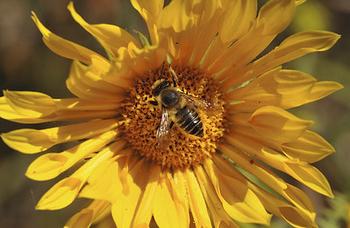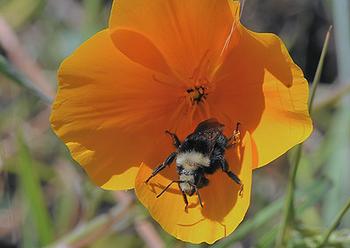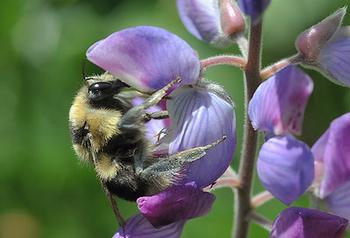Spring 2024
Our Veggies need our Pollinators
by Laurinda Ochoa

Yay!!! The plants are beautiful! But where is the fruit? Where are the baby tomatoes, newly forming squash, cucumbers, peppers, and other summer produce of our dreams? What’s going on?

What are pollinators, and Why Do We Care?
Pollinators are those insects, birds, and even bats that transfer pollen from one fruit and vegetable flower to another. The transferred (male) pollen from the first visited flower fertilizes the (female) pistil of the recipient flower. The pollen travels down to the ovary, and the fruiting parts begin to grow. Without fertilization, fruit will not form, no matter how healthy the plant is or how many flowers the plant produces.

So, If your vegetables are not producing fruit and the soil, sun, temperature, and watering are all appropriate for your plants, the problem may be a lack of pollinators. While some experienced home gardeners are comfortable taking a small brush and transferring pollen from the male flowers or male parts of a flower to the female parts, most gardeners can take the following steps to encourage pollinators to visit their gardens and fertilize their plants.
Do Not Use Pesticides or Insecticides
A healthy garden environment should not need harsh pesticides and insecticides that kill or harm our pollinators. Many hired gardeners routinely apply pesticides, insecticides, and herbicides whether or not they are actually needed. The University of California has a website, Integrated Pest Management Program (UC IPM), where home gardeners can look up natural and organic methods to control any pests. Many insects that people assume are harmful may actually play a beneficial role in the home garden. By doing a little research, you may learn that you don’t need the harmful chemicals you or your gardener are applying.

Many gardeners have learned to plant flowers, herbs, and other plants that produce pollen and nectar that attract pollinators. Choosing a mix of native plants and flowers that provide food and shelter to pollinators during our vegetable growing season is an easy and beautiful way to encourage insects to visit your yard and pollinate your vegetables.
Here is a link to a previous article on Creating a Bee Friendly Garden.
Learn About Your Local Pollinators and Educate You, your Family and Neighbors
Our children learn about the importance of pollinators in school. Many schools have classroom gardens where the students plant vegetables and flowers to attract pollinators. Ask your children or your neighbor’s children to help you spot pollinators in your garden.
After you identify your pollinators, it’s easy to research what plants and flowers you should grow to encourage the bees and other insects to visit your yard and to help you and your beautiful new plants have a successful and productive summer and fall vegetable garden.
